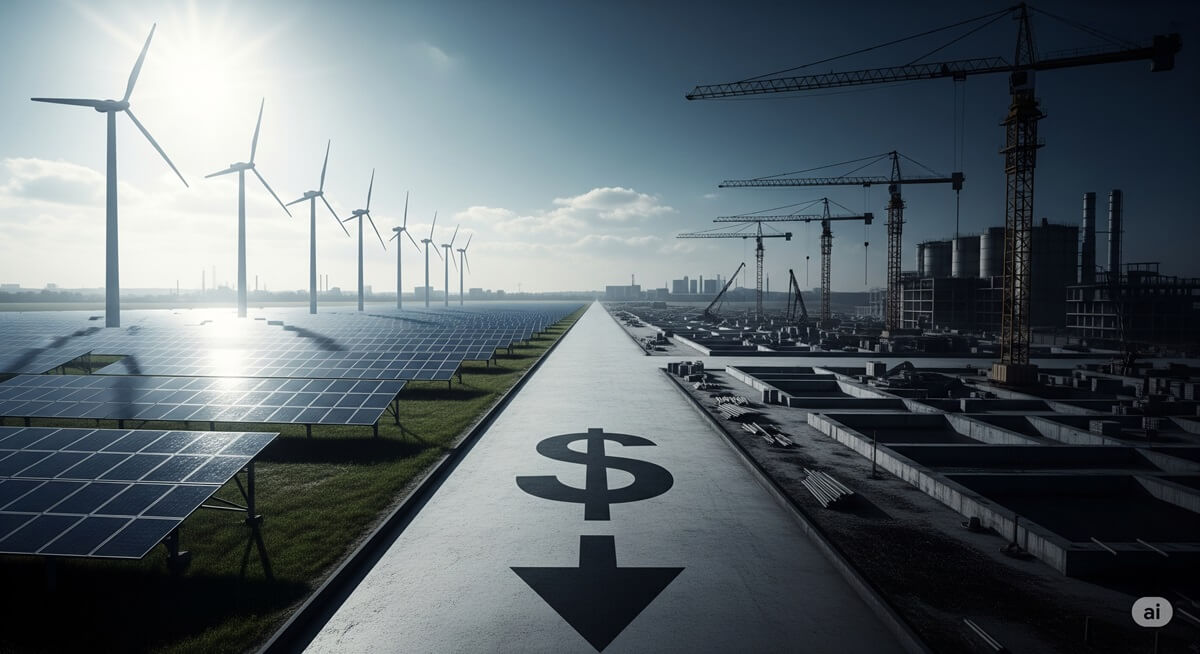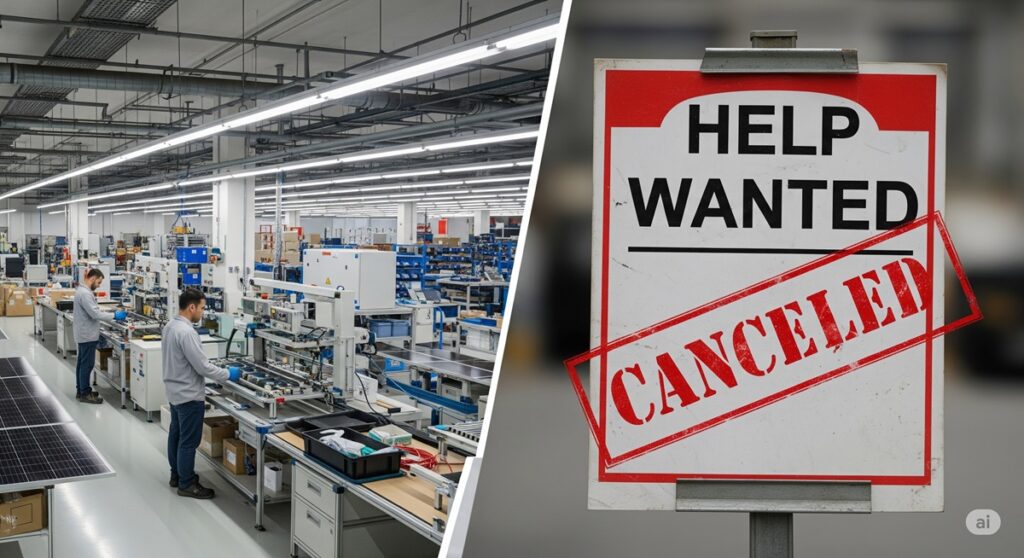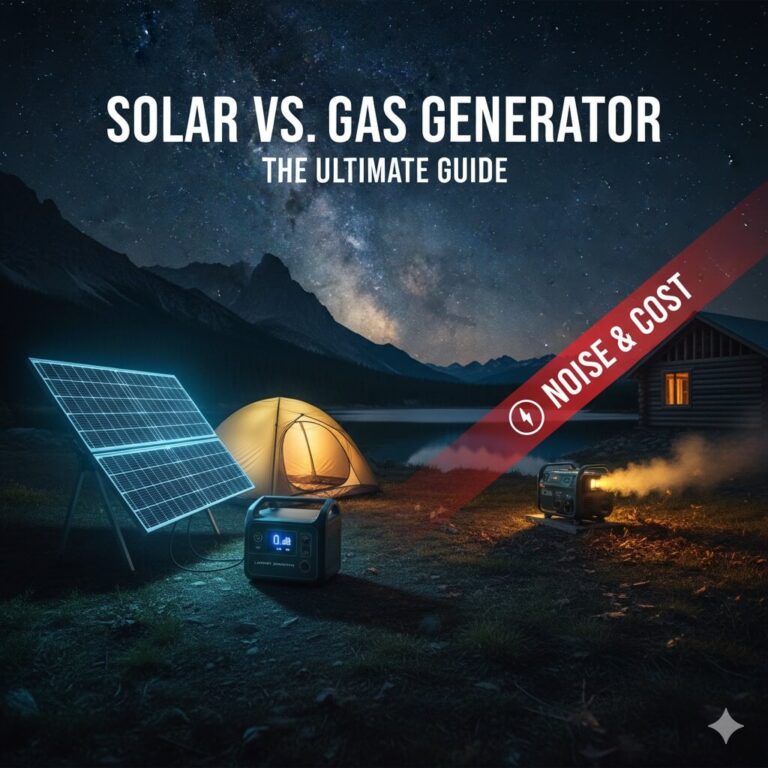US Clean Energy Investment at a Crossroads: $14 Billion in Project Cancellations in 2025

$14 Billion Loss: Is US Clean Energy Investment at a Crossroads in 2025?
The American clean energy sector, once buoyed by ambitious policy and robust investment, finds itself at a critical juncture in 2025. A staggering $14 billion in clean energy and clean vehicle factory investments have been canceled or delayed across the United States in the first five months of this year. This alarming figure, accompanied by over 10,000 lost or delayed jobs, paints a stark picture: the nation’s green energy aspirations are facing significant headwinds, forcing stakeholders to ask if US clean energy investment is truly at a crossroads.
This isn’t merely a slowdown; it’s a sharp reversal in momentum that threatens to derail progress toward ambitious climate targets and undermine America’s competitiveness in the global clean energy race. While the reasons are multi-faceted, one dominant factor looms large: escalating policy uncertainty surrounding the future of federal clean energy tax credits.
This article delves into the scale of these cancellations, unravels the primary drivers behind them, examines the sectors and regions most affected, and ponders the profound implications for America’s energy transition.
- $14 Billion Loss: Is US Clean Energy Investment at a Crossroads in 2025?
- 1. The Scale of the Setback: Billions Lost, Thousands of Jobs Jeopardized
- 2. The Primary Driver: Policy Uncertainty and the IRA Under Threat
- 3. Beyond Policy: Other Headwinds Facing Clean Energy
- 4. The Ironic Impact: Red States Feeling the Green Loss
- 5. The Crossroads: What’s Next for America’s Energy Transition?
- Frequently Asked Questions (FAQs) About US Clean Energy Cancellations
- Q1: How much clean energy investment has been canceled or delayed in the US in 2025?
- Q2: How many jobs have been impacted by these cancellations this year?
- Q3: What is the primary reason for these clean energy project cancellations?
- Q4: Which clean energy sectors are most affected by these cancellations?
- Q5: What are the broader implications of these cancellations for the US?
1. The Scale of the Setback: Billions Lost, Thousands of Jobs Jeopardized
The figures from early 2025 are striking and underscore the rapid deterioration of investment confidence:
- Rapid Acceleration of Cancellations: Over $14 billion in clean energy and clean vehicle factory investments have been announced as canceled or significantly delayed since January 2025. This includes a notable $4.5 billion in April alone, pushing the first quarter of 2025 to a record high for project cancellations at $8 billion.
- Job Losses Mount: Accompanying these investment losses are approximately 10,000 new jobs that were expected but are now stalled or eliminated for 2025. Looking back since the Inflation Reduction Act (IRA) was signed in August 2022, a total of 45 announced projects have been canceled, closed, or downsized, linked to nearly 20,000 jobs and $16.7 billion in investments.
- Affected Sectors: The brunt of these cancellations has been felt disproportionately in battery manufacturing, electric vehicle (EV) production, solar manufacturing, and wind generation. Specifically, more battery projects were canceled in Q1 2025 than in the previous two years combined, highlighting the acute impact on this crucial sector. Hydrogen and carbon capture projects also saw significant setbacks, with the DOE canceling $3.7 billion in grants for 24 such projects.
This dramatic shift from the boom of 2023-2024 is a wake-up call, signaling a profound challenge to the trajectory of US clean energy investment.

2. The Primary Driver: Policy Uncertainty and the IRA Under Threat
The most significant factor fueling this wave of cancellations is the growing fear and uncertainty over the future of federal clean energy tax credits, particularly those established under the landmark Inflation Reduction Act (IRA).
- The “One Big Beautiful Bill Act”: A proposed tax and spending package, dubbed the “One Big Beautiful Bill Act” by the House of Representatives and now under Senate review, threatens to revoke or significantly curtail many of the clean energy incentives that have spurred investment since the IRA’s enactment in 2022. These include crucial tax credits for solar, wind, battery, and EV manufacturing.
- “Tax-Credit Whiplash”: Developers and investors had priced projects based on the assumption of these federal rebates. The sudden legislative threat creates “tax-credit whiplash,” making financial models untenable and deterring new commitments. Lenders, too, are hesitant to finance projects amidst such significant policy ambiguity.
- Administrative Actions: Compounding this legislative uncertainty are executive actions, such as the Department of Energy’s (DOE) recent cancellation of approximately $3.7 billion in clean energy grants. These cancellations, affecting mostly carbon capture and industrial decarbonization projects, further erode investor confidence in long-term government support.
- Industry Outcry: Industry groups like Environmental Entrepreneurs (E2) are sounding the alarm, stating that this “business uncertainty is clearly taking a greater and greater toll on US manufacturing and jobs.” They warn of further construction halts and layoffs if the proposed tax plan becomes law.
This volatile policy environment directly translates into investment hesitancy, as companies are unwilling to commit billions of dollars to projects whose financial viability could be undermined by legislative changes.
3. Beyond Policy: Other Headwinds Facing Clean Energy
While policy uncertainty is paramount, other factors are also contributing to the challenging environment for US clean energy investment:
- Tariffs and Trade Actions: Evolving tariff changes, particularly on critical minerals and components from certain regions, introduce cost volatility and supply chain complexities for developers. These can squeeze already thin project margins.
- Inflationary Pressures: Persistent inflation in material costs (e.g., steel) and labor continues to drive up the overall cost of project development and manufacturing.
- Demand Cool-Down in Specific Sectors: While overall clean energy demand remains strong, some segments, like EV sales, have experienced a “demand cool-down” after two blockbuster years. This can impact the immediate need for new battery gigafactories.
- Nascent Company Struggles: Some newer companies in emerging clean energy fields may face inherent financial or operational challenges, independent of policy, which can contribute to project delays or cancellations.
- Permitting and Siting Hurdles: While not new, ongoing challenges with permitting processes and siting for large-scale energy infrastructure continue to add delays and costs to projects.
It’s important to note that these US-specific challenges contrast sharply with global trends. The International Energy Agency (IEA) projects global energy investment to reach a record $3.3 trillion in 2025, with clean energy investment outpacing fossil fuels. This highlights that the current US setbacks are largely domestically driven by specific policy debates and macroeconomic factors.
4. The Ironic Impact: Red States Feeling the Green Loss
Perhaps one of the most striking ironies of the current situation is the disproportionate impact of these cancellations on areas that had initially benefited most from the IRA:
- Republican Districts Hit Hardest: Over $12 billion of the shelved projects and 13,000 jobs lost or delayed are located in Republican congressional districts. These are the very districts that attracted the lion’s share of clean energy factory announcements following the IRA’s passage in 2022.
- Economic Vulnerability: States like Tennessee and Georgia, which have made significant investments in EV and battery production, are particularly at risk, as cancellations threaten new job creation and economic diversification in regions that previously embraced clean energy manufacturing.
- Political Repercussions: The data suggests a potential political boomerang, where legislative efforts to roll back clean energy tax credits could directly harm the local economies and job markets of the very communities represented by those supporting such changes.
This geographic impact underscores the tangible economic consequences of policy instability and the potential for a self-inflicted wound to local economies.

5. The Crossroads: What’s Next for America’s Energy Transition?
The $14 billion in canceled clean energy projects places US clean energy investment at a critical crossroads. The path chosen in the coming months will determine whether this is a temporary blip or a significant derailment of America’s climate and economic goals.
- Risk to Climate Targets: Delays and cancellations threaten the US’s ability to meet its ambitious climate targets, including achieving a 100% clean electricity grid by 2035 and significantly reducing emissions. Each canceled project represents lost progress towards these vital objectives.
- Competitiveness Concerns: As other nations (like China, which installed 64% of all new global renewable energy in 2024) continue their aggressive clean energy buildup, policy instability in the US risks ceding global leadership in critical clean technologies and supply chains.
- Call for Certainty: Clean energy advocates and industry leaders are united in their call for policy stability and certainty. They emphasize that consistent federal support is essential to drive the long-term, large-scale investments required for a successful energy transition.
The current situation serves as a powerful reminder: while the private sector is eager to invest in the clean energy future, it requires a predictable and supportive policy environment. Whether the US navigates this crossroads towards sustained clean energy growth or succumbs to prolonged uncertainty remains to be seen. The decisions made by policymakers in Washington will directly shape the nation’s energy future and its place in the global clean economy.
Frequently Asked Questions (FAQs) About US Clean Energy Cancellations
Q1: How much clean energy investment has been canceled or delayed in the US in 2025?
A: Over $14 billion in clean energy and clean vehicle factory investments have been canceled or delayed in the first five months of 2025.
Q2: How many jobs have been impacted by these cancellations this year?
A: Approximately 10,000 new jobs expected from these projects have been canceled or delayed in 2025. Since August 2022, nearly 20,000 jobs linked to abandoned clean energy projects have been tracked.
Q3: What is the primary reason for these clean energy project cancellations?
A: The primary reason is rising fear and uncertainty over the future of federal clean energy tax credits and policy, particularly due to a proposed House bill that threatens to roll back incentives from the Inflation Reduction Act (IRA).
Q4: Which clean energy sectors are most affected by these cancellations?
A: Battery manufacturing, electric vehicle (EV) manufacturing, solar manufacturing, and wind generation/manufacturing have been most significantly impacted. Hydrogen and carbon capture projects have also seen cancellations due to withdrawn government grants.
Q5: What are the broader implications of these cancellations for the US?
A: These cancellations threaten the US’s ability to meet its climate goals, risk undermining its competitiveness in the global clean energy market, and highlight the critical need for stable and consistent energy policy to drive investment and job creation.



